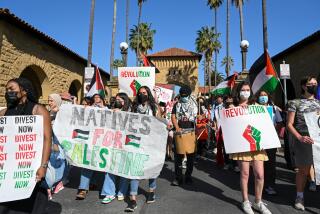Beijing Students Mark Attack at Tian An Men : China: Two years after crackdown on democracy, protests are surreptitious and the security tight.
- Share via
BEIJING — Students at Beijing University on Monday smashed bottles and yelled out from dormitory rooms in a midnight protest marking the second anniversary of the suppression of the Tian An Men Square pro-democracy demonstrations.
Students had been warned by school officials that anyone joining memorial protests or even watching them would be punished. Monday’s protest provided considerable anonymity but was risky for anyone who might be identified as a participant.
Even so, about 20 students could be seen outside a dormitory just inside a campus wall, right at the center of the protest. Other participants remained inside the residence halls.
Beijing University has special importance in China as the nation’s most prestigious campus. It also was a key center for launching the 1989 demonstrations.
Monday’s protest took place at graduate student dormitories at the western edge of the campus, where foreign journalists, barred from entry onto the university grounds, could observe what happened. The protest broke out after about 30 foreign reporters and 50 Chinese police had gathered in a street adjacent to the dormitories, waiting to see what would happen.
Earlier in the evening, about 100 students gathered in small groups near the campus library. While there were no speeches, those present, according to a European witness, seemed to understand that people had gathered in memory of the bloody night of June 3-4, 1989, when the Chinese army shot its way into Beijing, killing hundreds, perhaps thousands.
Shortly after 10 p.m., a young man sitting on the grass outside the library began to sing. Three campus security officers quickly ordered him to stop.
“We can’t even sing,” complained another student, within earshot of the European. “What kind of people are we?”
Then two plainclothes security officers, equipped with a video camera and a bright light, began filming those present, for later identification and possible punishment. Many turned their heads away but stayed in place.
When campus security began demanding to see student identification, one young man argued back: “I’m not a student, I’m a teacher. We don’t even have freedom to take a walk!” Three campus security agents grabbed him, but when a young woman with him urged him to leave, he managed to break away and was allowed to depart, the European said.
School faculty, officials, campus security and at least three paramilitary police officers then managed to clear students out of the area, but less than an hour later the bottle-breaking incident erupted. The sound of at least a dozen bottles shattering and also some other crashing noises could be heard during the protest. Afterward, a strip of road just across the campus wall from one of the dormitories could be seen covered with broken glass.
The smashing of bottles first became widely understood as a political protest during the 1989 pro-democracy movement. The Chinese word for small bottle, xiao ping, sounds the same as the given name of China’s senior leader, Deng Xiaoping, 86, who is widely blamed for ordering use of the army to suppress the Tian An Men Square demonstrations.
Police had allowed foreign correspondents to gather on the public street closest to the graduate student dormitories. But within minutes after the bottle-throwing began, police started ordering television crews to stop taking pictures. They briefly detained Peter Rosenfeld, a cameraman for the Canadian Broadcasting Corp., taking him into a nearby building and confiscating his video film, then releasing him.
Police also ordered CBC correspondent Patrick Brown into a police car after he persistently questioned their detention of Rosenfeld. Brown said he was taken to a nearby police station and questioned by non-uniformed officers, who asked him what he was doing out so late.
“I said we journalists work very late, and so do policemen,” Brown recalled after his release. “He said, ‘I think you know what we mean.’ I said, ‘I think you know what I mean.’ And we both chuckled.”
Brown was detained for about an hour before being released. The incident “was all very genial,” he said, “but they did confiscate our pictures, and I’m not happy about that.”
Tian An Men Square, center of the 1989 protests, was used for a ceremony Monday morning but was open to the public Monday afternoon and evening. More than 1,000 Chinese, many of them visitors from other provinces, were in the huge square on a warm and sunny afternoon. There also were at least 100 plainclothes police. Many carried walkie-talkies, while others could be identified by their activity photographing foreigners.
At about midnight, uniformed paramilitary police sealed off the square. Roadblocks, at which officers demanded to see drivers’ identification, were scattered around the city. At one roadblock northeast of the Beijing University campus, a paramilitary policeman stood guard with a bayonet-tipped rifle.
More to Read
Sign up for Essential California
The most important California stories and recommendations in your inbox every morning.
You may occasionally receive promotional content from the Los Angeles Times.












